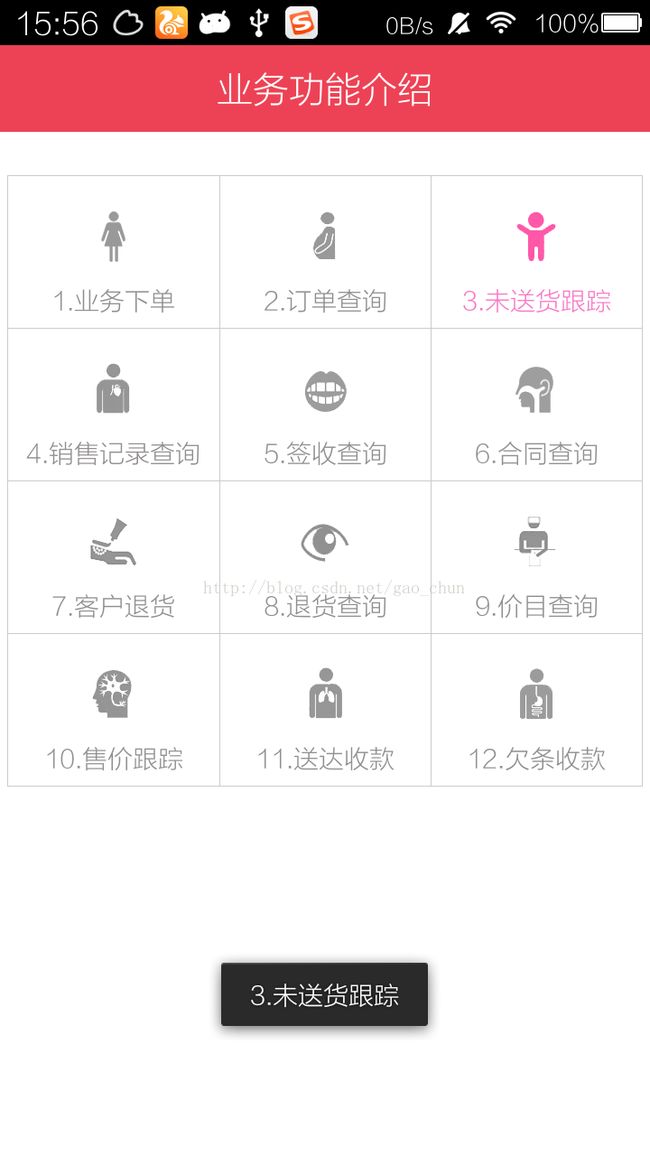Android 中使用代码动态网格布局
Android 中使用代码动态网格布局
本文介绍在android中使用代码动态布局,有时候根据不同的需求,比如需要根据服务器上的条目个数来决定app中页面布局控件(显示个数,图标等)。此处介绍通过java代码进行动态布局。
一、效果图:
图片资源随便找的,将就将就吧
二、给出xml文件布局
三、子条目xml布局文件
如图:

四、java代码动态布局
/**
* @author gao_chun
*
*/
public class MainActivity extends Activity implements OnClickListener{
private ViewGroup mMoreLayout; //父布局容器(动态加载的资源图片和文字等布局都将添加在其里面)
/* (non-Javadoc)
* @see app.ui.TitleActivity#onCreate(android.os.Bundle)
*/
@Override
protected void onCreate(Bundle savedInstanceState) {
super.onCreate(savedInstanceState);
initUI(); //保证启动方法的唯一性
}
private void initUI() {
setContentView(R.layout.activity_main);
//找到该容器(这里的控件为LinearLayout,转换为ViewGroup是因为ViewGroup是容器的基类)
mMoreLayout = (ViewGroup) findViewById(R.id.layout_more);
//由于文字也是动态生成,使用android中array文件定义资源文件,并取出
final String[] categories = getResources().getStringArray(R.array.categories);
final int size = categories.length; //String[]的长度
final int rowCount = size / 3; //需要布局的行数(每行三个)
/**
* 动态添加布局方法封装
* 参数 1.父容器 2.资源文字数组 3.从第几个开始 4.行数
*/
fillViews(mMoreLayout, categories, 0, rowCount);
}
private void fillViews(ViewGroup layout, String[] categories, int start, int end) {
// 表格第一条线
View.inflate(this, R.layout.layout_line_horizonal, layout);
for (int i = start; i < end; i++) {
//找到索引,便于根据索引添加图片文件和文字
final int firstIndex = i * 3;
final int secondIndex = i * 3 + 1;
final int thirdIndex = i * 3 + 2;
final String firstCategory = categories[firstIndex];
final String secondCategory = categories[secondIndex];
final String thirdCategory = categories[thirdIndex];
//这里控制的是加载本地图片,通过应用包命找到 有规则命名的图片资源文件
//--->因为这里有两种效果,一是默认的图片,二是按下触发后的图片和文字
final int firstDrawableNormal = getResources().getIdentifier(String.format("ic_department_%02d_normal",
firstIndex + 1),"drawable",getApplicationContext().getPackageName());
final int secondDrawableNormal = getResources().getIdentifier(String.format("ic_department_%02d_normal",
secondIndex + 1),"drawable",getApplicationContext().getPackageName());
final int thirdDrawableNormal = getResources().getIdentifier(String.format("ic_department_%02d_normal",
thirdIndex + 1),"drawable",getApplicationContext().getPackageName());
final int firstDrawablePressed = getResources().getIdentifier(String.format("ic_department_%02d_pressed",
firstIndex + 1),"drawable",getApplicationContext().getPackageName());
final int secondDrawablePressed = getResources().getIdentifier(String.format("ic_department_%02d_pressed",
secondIndex + 1),"drawable",getApplicationContext().getPackageName());
final int thirdDrawablePressed = getResources().getIdentifier(String.format("ic_department_%02d_pressed",
thirdIndex + 1),"drawable",getApplicationContext().getPackageName());
//这里是将上面找到的 默认图片 和 按下时的图片 放入到 StateListDrawable缓存中
final StateListDrawable firstDrawable = new StateListDrawable();
firstDrawable.addState(new int[]{android.R.attr.state_pressed}, getResources().getDrawable(firstDrawablePressed));
firstDrawable.addState(new int[]{}, getResources().getDrawable(firstDrawableNormal));
final StateListDrawable secondDrawable = new StateListDrawable();
secondDrawable.addState(new int[]{android.R.attr.state_pressed}, getResources().getDrawable(secondDrawablePressed));
secondDrawable.addState(new int[]{}, getResources().getDrawable(secondDrawableNormal));
final StateListDrawable thirdDrawable = new StateListDrawable();
thirdDrawable.addState(new int[]{android.R.attr.state_pressed}, getResources().getDrawable(thirdDrawablePressed));
thirdDrawable.addState(new int[]{}, getResources().getDrawable(thirdDrawableNormal));
// 父布局
final LinearLayout linearLayout = new LinearLayout(this);
// 第一个子布局
View.inflate(this, R.layout.layout_line_vertical, linearLayout);
View.inflate(this, R.layout.layout_department, linearLayout);
View.inflate(this, R.layout.layout_line_vertical, linearLayout);
// 第二个子布局
View.inflate(this, R.layout.layout_department, linearLayout);
View.inflate(this, R.layout.layout_line_vertical, linearLayout);
// 第三个子布局
View.inflate(this, R.layout.layout_department, linearLayout);
View.inflate(this, R.layout.layout_line_vertical, linearLayout);
LayoutParams layoutParams = new LinearLayout.LayoutParams(LayoutParams.MATCH_PARENT,LayoutParams.WRAP_CONTENT);
layout.addView(linearLayout, layoutParams);
// 表格最后一条线
View.inflate(this, R.layout.layout_line_horizonal, layout);
//根据索引getChildAt到指定的位置
final View firstView = linearLayout.getChildAt(1);
firstView.setTag(firstCategory); //设置tag,便于在后面判断点击的哪一个
firstView.setOnClickListener(this); //设置点击
final TextView firstTextView = (TextView) firstView.findViewById(R.id.text_title);
firstTextView.setText(firstCategory); //设置文字
final ImageView firstImageView = (ImageView) firstView.findViewById(R.id.image_icon);
firstImageView.setImageDrawable(firstDrawable); //将之前缓存的图片设置出来
final View secondView = linearLayout.getChildAt(3);
secondView.setTag(secondCategory);
secondView.setOnClickListener(this);
final TextView secondTextView = (TextView) secondView.findViewById(R.id.text_title);
secondTextView.setText(secondCategory);
final ImageView secondImageView = (ImageView) secondView.findViewById(R.id.image_icon);
secondImageView.setImageDrawable(secondDrawable);
final View thirdView = linearLayout.getChildAt(5);
thirdView.setTag(thirdCategory);
thirdView.setOnClickListener(this);
final TextView thirdTextView = (TextView) thirdView.findViewById(R.id.text_title);
thirdTextView.setText(thirdCategory);
final ImageView thirdImageView = (ImageView) thirdView.findViewById(R.id.image_icon);
thirdImageView.setImageDrawable(thirdDrawable);
}
}
/* (non-Javadoc)
* @see app.ui.TitleActivity#onClick(android.view.View)
*/
@Override
public void onClick(View v) {
final Object tag = v.getTag(); //通过之前setTag找到点击位置
if (tag != null) {
String department = (String) tag;
Toast.makeText(this, department, 0).show();
} // else ignored
}
}在onClick事件中通过布局时设置的Tag找出用户点击的是哪一个具体的Layout
注:关于 getResources().getIdentifier 方法可参考:http://blog.csdn.net/gao_chun/article/details/45891383
欢迎下载源码:http://download.csdn.net/download/gao_chun/8740979
转载请注明.
